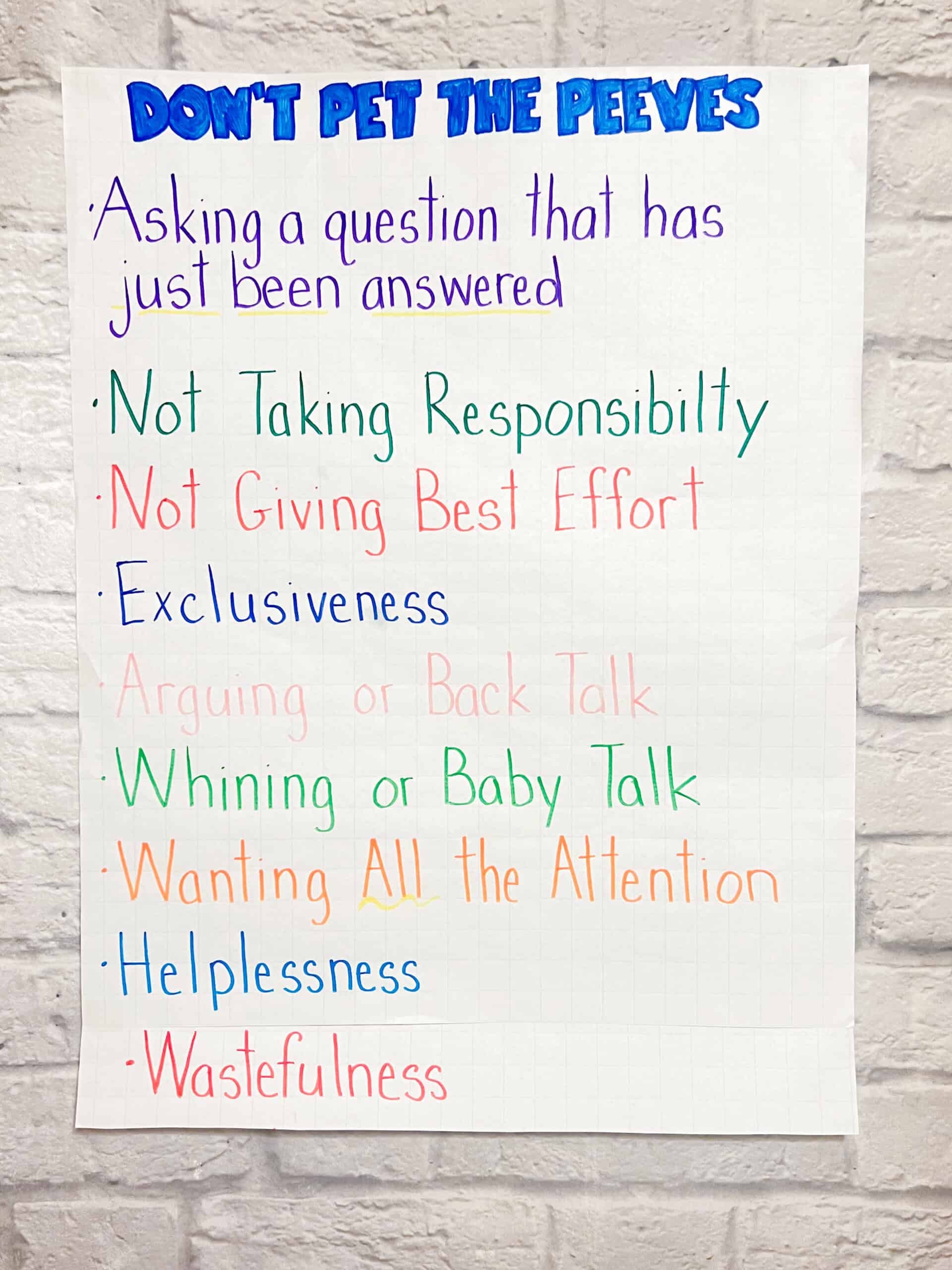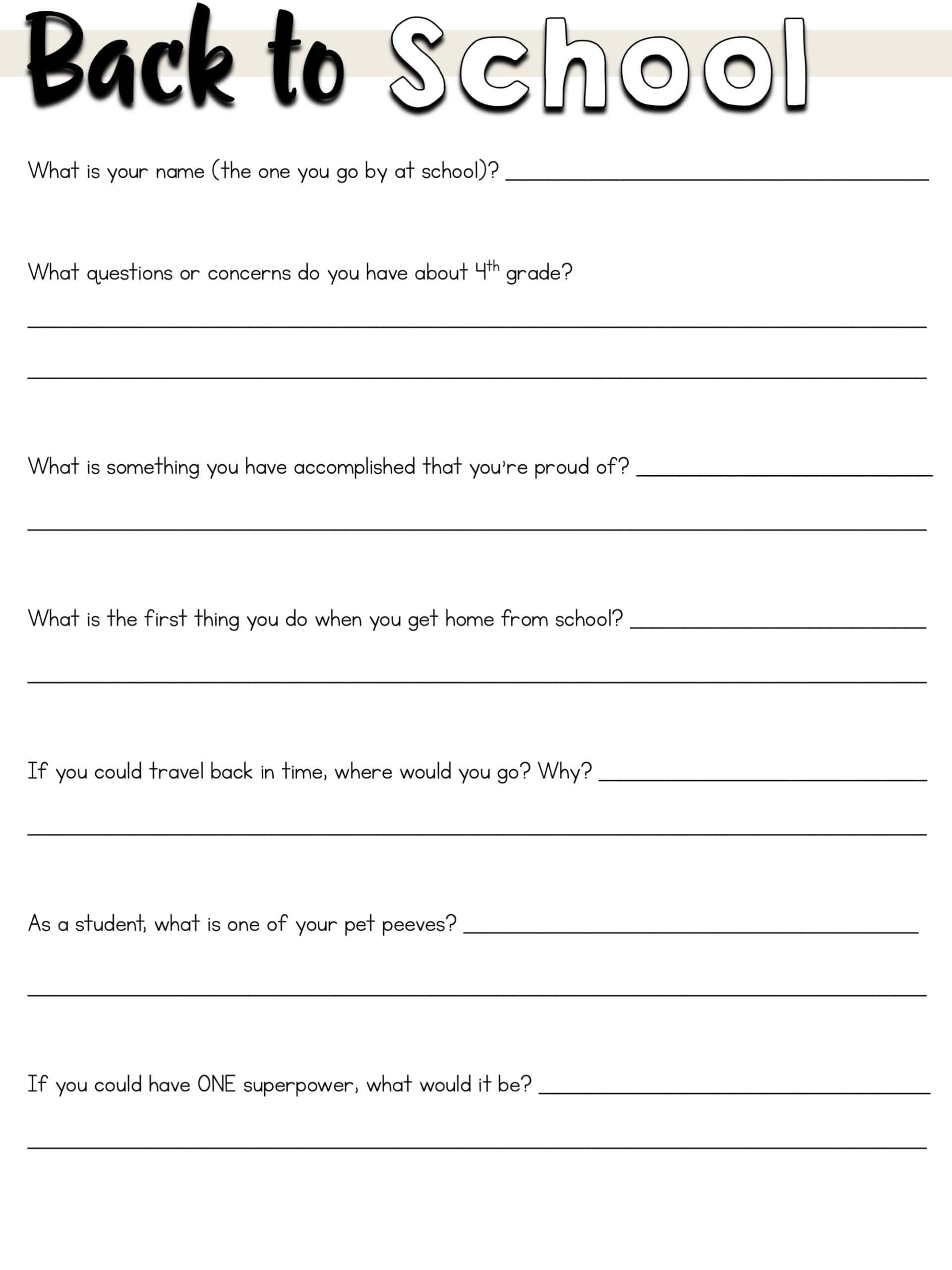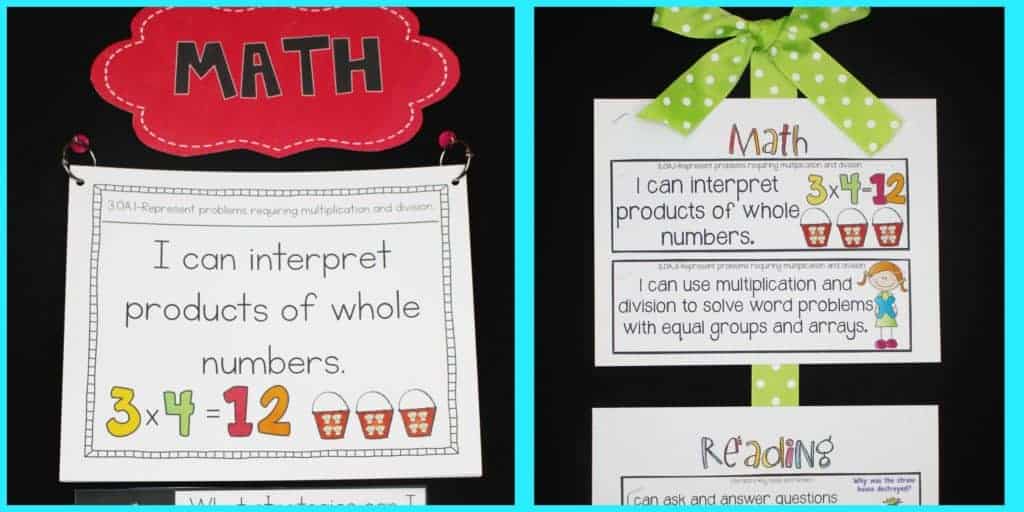We all have our teacher pet peeves. These are the things that drive us crazy! They can be serious, and they can be petty (crooked desks). Either way, they’re real to us!
For the most part, my classroom runs smoothly. When working with students, I’m flexible, accommodating, and choose my battles carefully. But, there are some things that absolutely drive me up the wall.
This year I’m going to use these teacher pet peeves as part of my back to school procedural lessons. I’ll keep it light and silly, but I do want to put them out there to help students adapt to the culture of the classroom. (BTW-This chart is in my house, not my classroom).

My Top 10 Teacher Pet Peeves
In this post, I’ve shared my top ten teacher pet peeves. But, I don’t want to complain for the sake of complaining. I’ve also shared strategies I’ve used to reduce these issues.
1. Asking a question that has literally JUST been answered
This is my absolutely my top, and it’s the one that occurs most frequently. I totally and completely understand that some students struggle to pay attention. I know I do! But, I can give a direction five times, include written directions and examples on an assignment, and display directions on my classroom screen, and I can almost guarantee that someone will ask, “What do we do…”.
I want to clarify that this is not talking about students who are confused with content or even organizing thoughts. I can work with that all day. That’s completely different from having students expect to be individually told the directions.
I’m a strong advocate for teaching students how to be independent and self-reliant, so I teach students what to do when they are stuck, confused, or generally have no idea what to do. I don’t expect them to walk in the door with those skills, so I will make that part of my instruction.
You can see this blog post for how to teach students these skills.
2. Not Taking Responsibility
Children, and some adults, have a way of wanting to pass the blame. I want my students to learn to take responsibility for their actions.
If I catch a student doing something wrong, I do not want to hear, “But he did it first” or “But she told me to”. I teach students that’s not okay in my classroom. If you did it, own up to it.
I also don’t let my students place the blame on their parents. Far too often children try to make their parents responsible for things that are completely age-appropriate, “But my mom didn’t remind me to do my homework” or “My dad didn’t check my backpack”.
Of course, some things are outside students’ control, and I’m not talking about those things. I’ll be the first to admit that I have thrown away my own children’s homework, so I get that it happens. These are things that are within their control.
3. Not Giving Best Effort
There are few things more frustrating than seeing a student not reach their potential due to them choosing to not put much effort into their work. Apathetic students are typically not self-motivated and often cause disruptions to those that are trying to learn.
There can be various reasons why a student may not be putting in the effort they are capable of. Some of the most common reasons include:
- Some students don’t try because they feel as if they can’t succeed, so there is no point in trying.
- Some students don’t try because they are afraid of trying and failing. Many time perfectionist don’t want to put in effort if they feel like they can’t do something perfectly.
- Students may not see the value or relevance of the work they are being asked to do.
- Students may have personal issues or challenges outside of school, which commonly impact school performance and behavior.
I try to understand the reasons behind low effort and work with students to address any underlying issues. When I understand the bigger picture, I can provide more support for the student.
I do believe some students give minimal effort because they just want to be finished. Somehow they have developed a mindset of I can play as soon as I complete my work, so let me rush through it as fast as I can. It takes me months to undo this mindset.
4. Exclusiveness
We all know that being excluded hurts. It breaks my heart to hear, “You can’t join” or “Don’t sit here.” or “I’m saving this seat” or “I already have a partner”. It also hurts to see children hurt listening to classmates talk about sleepovers and birthday parties they weren’t invited to.
I get it. Students are not always going to be friends with all of their classmates. Sometimes they can’t invite everyone to a party. It’s reality, but I can’t allow intentional exclusiveness in the classroom.
At the beginning of the year I try to closely observe the social dynamics of my new class. It’s easy to forget that these are young children who are still learning to navigate complex social structures. It’s why I always start the year with this resource that helps teach social skills. For most students, an awareness is all that it takes.
It’s also why I love these partner cards! I bought the cards last year, and my students LOVED them. My students were able to articulate how stressful it was when they needed to find a partner in class. This took the stress out of the equation.
5. Arguing and Back Talk
I do not argue with students or allow back talk. We are all going to have students who try to test their limits and push our buttons with arguing and back talk. When that happens, do not engage.
Some students are truly not aware of how argumentative they sound. You may need to teach appropriate responses for different situations. For example, if I tell Joey to close the game on his Chromebook, how should he respond? You can even make a chart of responses.
When a student argues or back talks, don’t take the bait and argue back or show frustration. Stay calm and to the point. Then, move on. In the moment, it’s typically not a good time to have a conversation about the issue.
When the child’s emotions are regulated, we may have a conversation about the situation. That’s when we can begin to get to the root of the problem and alternative responses. You can teach a lot during these informal chats-tone, body language, timing, etc.
6. Whining and Baby Talk
Baby talk is like nails on a chalkboard. To be clear, I am not talking about speech issues. Apparently this is a trend that has extended as far as high school. I also don’t put up with a lot of whining. I’m not talking about isolated incidents. I’m talking about students who moan about having to do work-every single day. When this happens I usually give “the look” and have students try again.
We do have conversations about asking “why”. It’s often a valid question, but I do teach students when and how to appropriately ask why. I also explain that there could be emergency situations where I need directions followed immediately and don’t have time to explain why. These conversations are powerful, because it helps students to see things from a bigger picture or a different angle.
7. Attention Seekers
Have you ever taught a student who needed to be the absolute center of attention, at all times? It’s exhausting and unfair to the other students. I always read The Invisible Boy to illustrate how this makes others feel.
Some students need more attention that others, and I want to provide them with what they need. However, once again, students have to be taught how to appropriately seek attention and what behaviors to avoid. Many times a student so desperately seeks attention, it results in them pushing away their classmates, which exacerbates the problem.
8. Helplessness
Academic learned helplessness isn’t new. I wouldn’t even call it a teacher pet peeve. It’s more of a concern, because it impairs students academically. In fact, I wrote a blog post that focuses on learned helplessness, which you can find here. The post discusses the importance of productive struggle and how to help students learn to utilize the resources in place for the extra help they may need.
What I’m seeing now is learned helplessness with executive functioning. To be clear, this is different from students who can’t or aren’t equipped to perform these executive functioning actions (yet). This is more along the line of not getting a new pencil if your current pencil breaks, not picking up a jacket after recess after being reminded, not being able to log in to a website (that has the username and password stored), not attempting to clean up a mess, not turning in a field trip form, etc.
Learned helplessness develops when children perceive that they can’t do thing on their own. Eventually, they determine it’s easier if someone else just does it all for them, which decreases their independence. This is why it’s critical that children learn to complete tasks on their own. I recently read an article by Ryan Wexelblatt who stated:
Kids who are diagnosed with ADHD and related challenges need to be taught concrete strategies to help them develop their executive functioning and reach a level of age-expected independence. They need repetition, consistency and most importantly, they need the ability to learn from their mistakes.
Regardless of your good intentions, if you are acting as your child’s executive functioning and not placing any demands on your child aside from academic performance you are inhibiting his or her ability to develop their executive function skills. If you can provide your child with “kid-friendly” strategies to help them improve their executive functioning and move towards independence you are preparing them for future success. I use the term “kid-friendly” because I find many executive functioning strategies are not practical because they are not designed for this generation of visual learners.
My goal for this school year is to find or develop more kid friendly strategies that can be used in the classroom.
9. Interruptions
Why is it so hard to recover after an interruption? I can be right in the middle of a great lesson. The momentum is going, and everyone’s engaged, and the smallest interruption can derail everything. After over 20 years in the classroom, I realize it can’t be avoided. We’re in the real world, and it comes with the territory. However, there are things we can do to minimize interruptions.
At the beginning of the year, I explicitly teach procedures on potential interruptions such as when to sharpen pencils or leaving for the restroom. We also discuss what types issues justify interrupting small group instruction. You need a sip of water-no. You are missing cards required for a sort-yes.
I never want to be a teacher who squelches a child’s spirit, so I’m careful with how I react to questions and comments not relevant to the lesson. How I respond typically depends of the child and the situation. Sometimes I may say something like, “Wow! That’s awesome! I can’t wait for you to tell me about it at recess.” Sometimes I may simply say, “Great, let’s save that for later so we an keep on track.”
Some interruptions are unavoidable. We’re required to keep our doors locked and closed, so I cannot count the number of knocks I hear in the day. It’s unreal.
10. Wastefulness
I pay for a lot of what we use in the classroom, and it really bothers me to see students wasting resources for no good reason. They may pull off the eraser on their pencils, break pencils, cut up erasers, stab erasers with their pencils (my son insists that this is fun), or pour glue on their hands. There can also be careless behaviors such as not putting lids back on glue sticks or the caps on markers that cause waste. Some students go through boxes of crayons like candy or lose their earbuds daily.
This is an issue that I am conflicted on how to best solve, because I see it from different perspectives. I know I can get these supplies donated, and I could just continuously distribute them as needed. But, I worry that I’m enabling wasteful behavior. On the other hand, I never want a student’s academics to suffer, so I don’t want to ever keep them from an activity because of a supply issue. Right now, I handle this on a case by case basis.
Student Pet Peeves
I’m all for fairness, so while teachers may have their teacher pet peeves, students have their own pet peeves! As a part of my open house activity, I’m going to have students one of their pet peeves.

I’m not certain what I’ll discover, but I anticipate a few things. I’m anxious to see how accurate these predictions are.
- Homework
- When one student gets in trouble for something but another student does it and doesn’t get in trouble
- Being late to lunch or recess
- Whole class consequences
- People going through their things
Isolated none of the above would be too bad. It’s the sheer volume and frequency of all of the above on a daily basis. On top of actually teaching that makes them so frustrating. Hopefully, some of these tips will reduce your frustrations. I’ve also starting a blog series that takes a deep look at solutions to each of these issues. The first one is ready to go!

